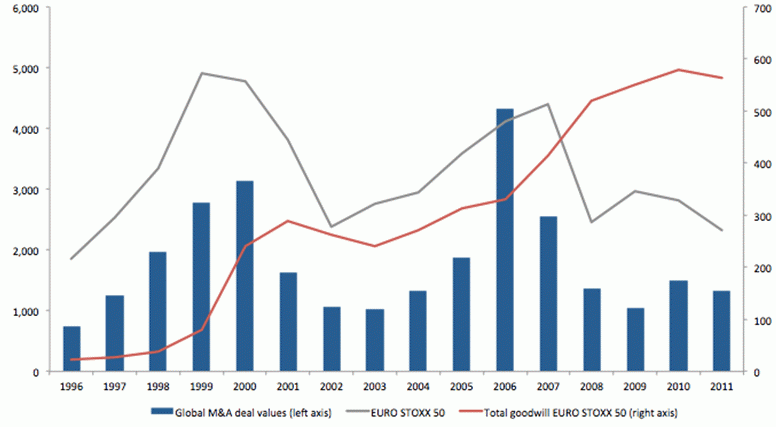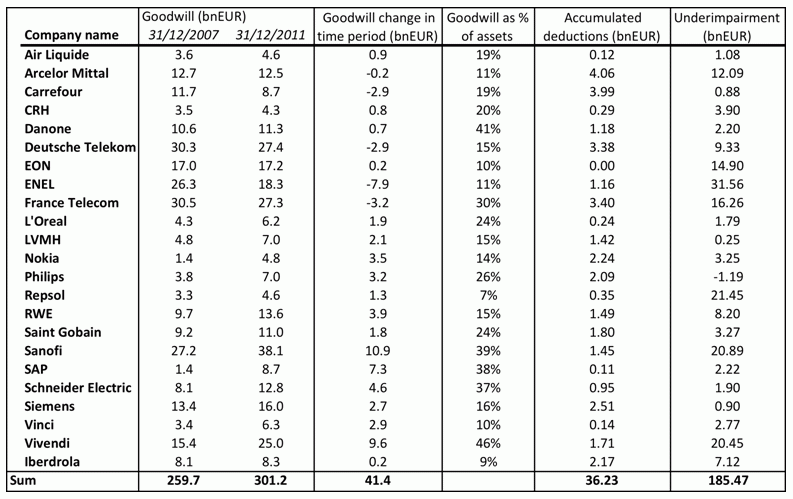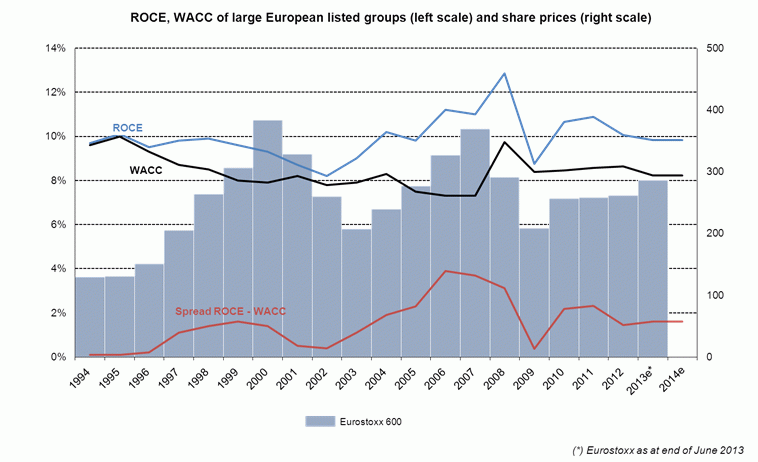Letter number 75 of July 2013
- TOPIC
- STATISTICS
- RESEARCH
- QUESTIONS & COMMENTS
News : The case of goodwill non-impairments: A study on the current situation with evidence from the European market
By Claes Christiansen
In accounting for goodwill[1] it seems that the interest of the management is not necessarily aligned with that of shareholders. When companies announce goodwill impairments, this is often perceived as a form of admitting past mistakes in their acquisition strategy. Thus it seems natural that managers try to avoid goodwill impairments in order to protect their own reputation (… and compensation).
On the other hand, equity investors value accuracy of financial reporting. The principle of prudence in accounting sets that assets should be depreciated when losing value below their historical booking amount. Should this principle be perfectly implemented this would allow equity investor to consider largely book equity as a minimum value for the value of equity. As goodwill impairments are non-cash and one-off items they should not accordingly be directly value relevant in standard valuation.
In addition, the possible over valuation of goodwill of in accounts also impacts lenders, equity being a key metrics to assess the financial situation and the borrowing capacity of a firm. Hence, the under-depreciation of goodwill could also be led by management willingness to maintain financial flexibility.
Research results
The research done is based on the simple notice that impairments of goodwill are largely disconnected from movement in stock prices. Whereas simple reasoning would have led to the opposite conclusion: if on average asset value are declining (drop in equity index), on average, the value of assets bought in the past should also lose value, this should sooner or later lead to an impairment of goodwill.
The chart below shows that over the last 25 years, stock market have experienced two peaks and two troughs, this cycle has been followed almost exactly by the M&A market; despite this, the level of goodwill in Eurostoxx 50 groups has almost constantly increased. It seems that the goodwill booked in the years 1999-2001 and 2006-2008 has hardly been impaired by those groups.
The research therefore seeks to test whether processes meant to ensure reporting accuracy (including review by external auditors) have efficiently insured that goodwill impairments have been properly implemented… or not.
The research measures by how far EURO STOXX 50 companies have impaired goodwill from 2007 until 2011. Based on the change in price-to-book ratio, a simple model was developed to measure the impairments the companies should have made in the given years.
This calculation leads to conclude that 23 of the 50 companies of the EURO STOXX 50 have materially not impaired enough goodwill and should have impaired another 185 billion Euros or an average of eight billion Euros, which represents a hefty 22 per cent of their total assets. Ten companies already account for 87 per cent of the under-impairment and five are responsible for 60 per cent. On the other side no group of the sample appears to have over impaired materially its goodwill.
In order to better understand the motivation for not impairing, the impact of impairment of goodwill for equity investors was assessed. If goodwill impairments were not value relevant, this would indicate that management’s interest in not impairing goodwill is not driven by market value consideration (but potentially their own reputation and compensation). To test this assumption, an event study was done to compare stock prices of companies that have significantly impaired their goodwill with companies that have experienced similar deviations from expected earnings but due to other reasons.
One month after the impairment the performance of the companies that have impaired goodwill were on average 3.8 per cent higher compared with peers that have missed their EPS targets due to other reasons. After one year the effect is still profound with the impairing company outperforming its peers by 2.7 per cent. The timing when the impairments are made is another indication that managers act in their own interests rather than in the interest of the shareholders when impairing goodwill. In the study 60 per cent of the impairments were made in the first three years after the new CEO had been put into place, and almost 40 per cent of the impairments were done within the first two years. It is important to stress that no significant impairment has done by a CEO who had made the acquisition earlier.
Although the outcome from the research may not be totally statistically relevant due to the limited number of companies analysed, the research shows a significant gap between the amount of goodwill on the balance sheets of the EURO STOXX 50 companies and its fair value. Also it provides further indication that in goodwill accounting interests between shareholders and management are not aligned. Although the European Securities and Market Authority seems to have realized and voiced the issue “that listed companies were taking an excessively optimistic view of the value of takeovers agreed in more buoyant times”, companies are not changing their behaviour. The top five companies that account for 60 per cent of the goodwill under-impairment have impaired a total of 6.3 billion Euros in 2012 accounts – not even 6 per cent of the total under-impairment.
We doubt that the redrafting of accounting principles may be a solution to address this issue. But we hope and believe that eventually market will auto regulate and investors may value in the long run smart and credible management rather than the ones trying to hide the obvious.
[1] For more on goodwill, see chapter 6 of the Vernimmen.
Statistics : ROCE, WACC and share prices of European listed groups
Correlation between the spread ROCE – WACC and share price of large European firms is striking. Striking but logical as value creation comes from a greater return obtained on an investment than the required rate of return.
This is an update of one of the many graphs to be found in the Vernimmen, this one in chapter 27
Research : Taxation of shareholders and investment
With Simon Gueguen – Lecturer-researcher at the University of Paris Dauphine
When cash is returned to shareholders, whether in the form of dividends or share buybacks, the amounts received are taxable. This taxation increases the cost of equity for companies that finance their operations through capital increases, compared with those who use their own cash. So, any change in the tax rate impacts differently on firms, depending on whether they have the cash they need to finance their capital expenditure internally or not. This is backed up by a recently published study[1] based on a sample of 7,661 firms in 25 different countries over 1990-2008.
The study relies on a large base of tax data that was built up for a previous article[2]. Thanks to this long period and the large number of countries covered, Backer et al were able to study the impact of 15 major tax reforms and 67 more modest amendments on the taxation of dividends and capital gains (for share repurchases). They measure the amount of cash available for self financing in three ways: cash flows generated by the business, free cash flows, and EBITDA, each time in proportion to total assets. The results obtained using the different measures[3] are similar, and each time confirm that changes in taxation of payouts impact differently on firms, depending on the level of their available cash.
Backer et al initially looked at changes to taxation that resulted in a rise or a drop in the tax rate on payouts of at least three percentage points. They then classified the firms in quintiles according to their cash flows. In the event of a decrease in taxation, firms with strong cash flows continue to invest more than those with weak cash flows, but the gap is reduced to 31%. In the event of a rise, the gap increases to 42%. In other words, when taxation on payouts gets heavier, firms that have to rely on external financing invest less. A linear regression, covering all of the years and all of the companies included in the study, confirms this effect.
When taxation increases, investments made become more dependent on cash flows. Additionally, the authors verify that capital increases are lower when taxation on payouts increases. A rise in taxation of 10 percentage points results, in the sample studied, of a 9% drop in share issues. So, high taxation is associated both with less investment and fewer share issues. At the same time, the financial leverage of firms is only slightly modified. Accordingly, debt does not constitute a perfect substitution for equity, contrary to the predictions of Modigliani-Miller. Firms that make use of external financing see their cost of capital increase.
These results may have interesting consequences in terms of economic policy. A policy of higher taxation of shareholder payouts steers investments to companies that have cash, and that are thus in sectors that are already well established. A policy of lower taxation encourages emerging sectors.
[1] B.BACKER, M.JACOB et M.JACOB (2013), Payout taxes and the allocation of investment, Journal of Financial Economics, vol.107, pages 1 à 24.
[2] M.JACOB et J.JACOB (2013), Taxation, dividends, and share repurchases : taking evidence global, Journal of Financial and Quantitative Analysis, forthcoming
[3] Authors use several benchmarks for taxation level (regulatory rate, average actual rate) and capex.
Q&A : Can one dollar of Apples cash reasonably be valued at one dollar?
As a result of its phenomenal capacity to generate positive free cash flows, around $42bn for the last financial year, a very strong internal culture which does not encourage it to make acquisitions (its largest acquisition was worth less than $1bn) and a very parsimonious dividends policy (in February 2012, Apple announced that it wanted to give back $45bn to its shareholders over 3 years), at end March 2013, the group had a cash position, net of all financial debt, of $145bn.
Under pressure from its shareholders, Apple announced in April that it wanted to return $55bn more to them, bringing dividends and share buybacks to $30bn per year over the next 3 years, a substantial part of which to be financed by debt. We might be surprised to see a group like Apple taking out debt, given its available cash of $145bn.
The reason can be found in a particular feature of US taxation system which, since it does not have a parent-subsidiary regime or its equivalent that is to be found in most developed countries, taxes all dividends received from subsidiaries at the normal corporation tax rate of 35%. Since a substantial portion of Apple’s profits are made and located outside the USA, a substantial portion of its cash is also located outside the USA so as to avoid a double taxation on its non American profits. The figure of $100bn has been cited.
Apple, like many other US multinationals in the same situation, is waiting for the US administration to announce a special tax reduction, as it has done occasionally in the past, i.e., to announce that over a certain limited period of time, the repatriation of profits made abroad to the USA will only be taxed at a reduced rate. Non-US cash will then be repatriated to the USA and can then be paid out to Apple shareholders since this group does not need the largest portion of its cash.
So, when valuing Apple’s cash, it does not seem reasonable to us to value one dollar of this non-US cash at one dollar. In fact, one dollar of a company’s cash is only worth one dollar if the company is able to invest it at its cost of capital [1], or failing that, to return it to its providers of funds through share buybacks or dividends or the advance repayment of bank or financial debts. An exception can be made for reasonable amounts of cash or cash waiting to be reinvested in the business. But Apple has so much cash that the group would never be able to find investment opportunities in its sector that would earn it its cost of capital. In addition, since it doesn’t have any bank and financial debt, it is difficult for it to repay such debts!
There remains the return to shareholders of equity, that rare resource, which here is idle as it is in the form of cash. However, in this case, the absence of a US parent-subsidiary regime means that there will be a hefty tax bill, 35% at the normal tax rate, if this cash is to leave the coffers of the subsidiaries and flow into those of the parent company. We should remember that only the parent company can pay dividends to its shareholders, even if these dividends are paid out of profits of the group as a whole.
Accordingly, it would be logical to discount Apple’s non-US cash by 35%. A lower rate could be used if it were thought likely that the US Treasury intended to announce a period of tax reductions on cash repatriated from international subsidiaries. It could be argued that, as long as dividends paid out of subsidiaries’ profits continue to be taxed at 35%, Apple will continue to park its cash outside the USA, and so accordingly, this discount is not justified. This situation, from a valuation point of view, would appear to us to be worse since in the current context of low interest rates, discounting income on this non-US cash at the cost of Apple’s equity (rate of return required by the investor on its equity), results in a discount that is much higher than 35%.
In our view, it would be difficult to value any other way, the cash that is destined to remain invested long term at a low interest rate, without the option of sending it to the parent company, except with a tax bill of 35%. Over and above this contingent example, the valuer will always be on the right track, in our view, if he or she seeks to understand where the group’s cash is located in the consolidated accounts. The ideal, of course, as any group financial director is well aware, is to have a rich parent company and poor subsidiaries, rather than the other way around! If not there is a cost, both in terms of financial management and in valuation.
[1] For more on this, see chapter 27 of the Vernimmen.



